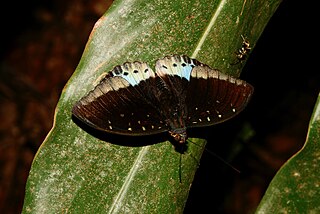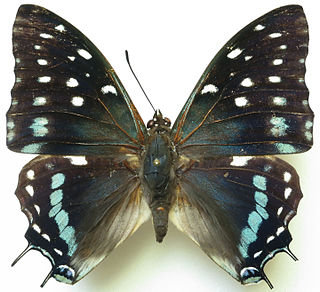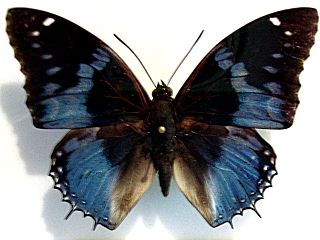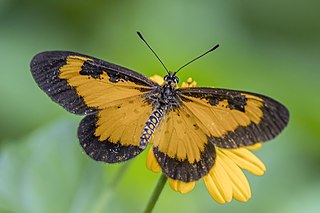
The morpho butterflies comprise many species of Neotropical butterfly under the genus Morpho. This genus includes more than 29 accepted species and 147 accepted subspecies, found mostly in South America, Mexico, and Central America. Morpho wingspans range from 7.5 cm (3.0 in) for M. rhodopteron to 20 cm (7.9 in) for M. hecuba, the imposing sunset morpho. The name morpho, meaning "changed" or "modified", is also an epithet. Blue morphos are severely threatened by the deforestation of tropical forests and habitat fragmentation. Humans provide a direct threat to this spectacular creature because their beauty attracts artists and collectors from all over the globe who wish to capture and display them. Aside from humans, birds like the jacamar and flycatcher are the adult butterfly’s natural predators.

The Menelaus blue morpho is one of thirty species of butterfly in the subfamily Morphinae. Its wingspan is approximately 12 cm (4.7"), and its dorsal forewings and hindwings are a bright, iridescent blue edged with black, while the ventral surfaces are brown. Its iridescent wings are an area of interest in research because of their unique microstructure. Due to its characteristic blue color, Morpho menelaus is considered valuable among collectors and was widely hunted in the 20th century.

The archdukes are a genus, Lexias, of tropical forest-dwelling butterflies that are common throughout Southeast Asia and Australasia. Members of the brush-footed butterfly family Nymphalidae, the genus is represented by about 17 species. Two very similar and coexisting genera are Tanaecia and Euthalia, the latter previously including some Lexias species. The largest species reach a wingspan of about 10 cm (4 in).

Limenitis arthemis, the red-spotted purple or white admiral, is a North American butterfly species in the cosmopolitan genus Limenitis. It has been studied for its evolution of mimicry, and for the several stable hybrid wing patterns within this nominal species; it is one of the most dramatic examples of hybridization between non-mimetic and mimetic populations.

Hypolimnas bolina, the great eggfly, common eggfly, varied eggfly, or in New Zealand the blue moon butterfly, is a species of nymphalid butterfly found from Madagascar to Asia and Australia.

Heliconius cydno, the cydno longwing, is a nymphalid butterfly that ranges from Mexico to northern South America. It is typically found in the forest understory and deposits its eggs on a variety of plants of the genus Passiflora. It is a member of the Heliconiinae subfamily of Central and South America, and it is the only heliconiine that can be considered oligophagous. H. cydno is also characterized by hybridization and Müllerian mimicry. Wing coloration plays a key role in mate choice and has further implications in regards to sympatric speciation. Macrolide scent gland extracts and wing-clicking behavior further characterize this species.

Archaeoprepona demophon, the one-spotted prepona, banded king shoemaker, or demophon shoemaker is a butterfly belonging to the family Nymphalidae.

Adelpha californica, the California sister, is a species of butterfly in the family Nymphalidae. They are common in California, but can also be found in western Nevada and Oregon, as well as in northern Baja California. The upper surfaces of their wings are dark brown to black with wide cream white bands dissecting both wings and two orange patches near the tips of the forewings. The underside is variously colored with browns, blue, orange, and white. A. californica is unpalatable to predators and is part of a large mimicry complex.

Agrias is a genus of Neotropical charaxine nymphalid butterflies found in South and Central America.

Zeuxidia is a genus of very large butterflies in the family Nymphalidae. They are "leaf" butterflies with a cryptic ventral pattern. The genus is Indomalayan (Burma through Indochina and the Philippines to Sumatra, Java and Borneo.

Lexias pardalis, the common archduke, is a butterfly of the family Nymphalidae.

Protogoniomorpha parhassus, the forest mother-of-pearl or common mother-of-pearl, is a species of Nymphalidae butterfly found in forested areas of Africa.

Charaxes castor, the giant emperor or giant charaxes, is a butterfly of the family Nymphalidae. It is found throughout the Afrotropical realm below the Sahel.

Charaxes etesipe, the savannah charaxes or scarce forest emperor, is a butterfly of the family Nymphalidae.

Cymothoe is a genus of butterflies in the subfamily Limenitidinae, the admirals and relatives. They are known commonly as gliders. The genus is distributed in the Afrotropical realm, where species are found mainly in forest habitat. mainly in the Guinean Forests of West Africa and the Congolian forests.

Charaxes smaragdalis, the western blue charaxes, is a butterfly of the family Nymphalidae. It is found from Senegal to Somalia, from Angola to Kenya and from Sudan to Egypt.

Acraea acerata, the falls acraea or small yellow-banded acraea, is a butterfly in the family Nymphalidae. It has an extensive range in sub-Saharan Africa.

Euphaedra cyparissa, the true forester, is a butterfly in the family Nymphalidae. It is found in Guinea, Sierra Leone, Liberia, Ivory Coast, Ghana, Nigeria, Cameroon, the Central African Republic and the Democratic Republic of the Congo. The habitat consists of drier forests and open wet forests or the edges of wet forests.

Cymothoe reinholdi, or Reinhold's creamy glider, is a butterfly in the family Nymphalidae. It is found in Nigeria, Cameroon, Gabon, the Republic of the Congo, the Central African Republic and the Democratic Republic of the Congo. The habitat consists of primary forests.

Hyantis is a monotypic nymphalid butterfly genus. Its sole species is Hyantis hodeva, which is found in New Guinea. It is uncertain which tribe this butterfly should be placed within.



















